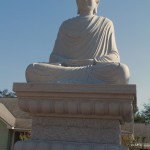Is the prodigal son emerging into the second half of life? He now realizes that money and wine, women, and song will not make him happy. This is the kind of crisis that either destroys us or launches us into the second half of life in the inner self. The prodigal son realizes that the eight impermanent, worldly concerns: gain, loss, praise, blame, pleasure, pain, fame, and defame (defamatory words) will not give him what he is looking for (Khai Thien, “The Core of Happiness,” White Sands Buddhist Center, Mims, FL http://cattrang.org/study/corehappiness.pdf). Buddhists says that right mind, non-dualistic mind is essential for living well in the second half of life. Is not this the “mind of Christ” that Paul encourages us to develop?
Happiness, right living is not about the self. Merton called this the false self which is defined by externals and who we think we are in this world. The true self is self in relationship to the Creator and the created. The true self is the inner self. The Buddhists say the true self is our face before we were born, our face created in the image and likeness of God. Right mind, true selfhood is achieved by placing ourselves in the presence of the Presence through meditation practice. I find very little difference between the methods expounded by the Venerable Khai Thien and those taught by Thomas Keating and Contemplative Outreach.
The foundational Buddhist thought is that life is dukka, suffering. We look for ways to avoid suffering, in the words of the old country song, “in all the wrong places.” Christians should grasp this truth because the cross is the key to resurrection. Life is about joy and suffering.
Happiness is not about avoiding suffering but rather about embracing life as it comes at us with a sense of equanimity. Christ or the Buddha comes to us disguised as our life. [I was listening to a tape on Buddhism and heard a song that sounded familiar, “The Buddha loves me. This I know because the Sutras tell me so!]
Read Khai’s definition of happiness, “Happiness is a deep sense of well-being, serenity and inner peace; importantly, it is not governed by outside conditions.” This is the definition for shalom—wholeness, health, well-being—and has huge implications for healing ministry and the use of meditation.
Happiness, the Christ life within, is really all about forgetting the small self and serving others. Khai says “what we need to build a life of happiness, we need to embrace and develop the following four Noble Virtues: (1) loving-kindness [this is the translation given to hesed in the Old testament.], (2) compassion, (3) sympathetic joy, and (4) equanimity. It is, like the Trinity, all about relationships.
The prodigal son meets the grace-filled, lavish extravagance of the Prodigal Father. Their relationship is reestablished instantaneously. Obviously, the older brother had not achieved equanimity and his heart was not very forgiving but, I bet that in the end he got it right and re-established his relationship with his father and brother.
I will be spending some time trying to grasp the connections between Christianity and Buddhism. No particular religious group has a grasp on total truth. Merton finally understood the commonalities when he experienced the smiling Buddhas at Polonnaruwa in Sri Lanka:
All problems are resolved and everything is clear. The rock, all matter, all life, is charged with dharmakaya… everything is emptiness and everything is compassion. I don’t know when in my life I have ever had such a sense of beauty and spiritual validity running together in one aesthetic illumination. Surely… my Asian pilgrimage has come clear and purified itself. I mean, I know and have seen what I was obscurely looking for. I don’t know what else remains but I have now seen and have pierced through the surface and have got beyond the shadow and the disguise.
The whole thing is very much a Zen garden, a span of bareness and openness and evidence… a beautiful and holy vision.” (“Asian Journal” pgs. 233 -236)
Paul Wilkes comments on Merton’s experience:
If we might extrapolate those words, it appears Merton, who had a rich sense of irony and humor, as well as a deep understanding of both Eastern and Western mysticism, intuited a profound insight in the immense statues—at once sad, sly, and knowing smiles. Merton’s hand-wringing days were over, the myriad questions now rendered irrelevant, the once precisely delineated steps to enlightenment-or union with the Almighty-were now but a feeble ladder that would soon be kicked away.
It is apparent that it was not Merton’s keen intellect that had finally decoded this higher power. Rather, his heart and soul were so completely subsumed on that day at Gal Vihara that there was no longer any need to do anything. He could simply rest in the simplicity of it all. Everything and nothing were but different words for the same reality. The venerable stages of the contemplative life had worked their mysterious power in Merton: the purgative-through decades of an ascetic life-had yielded to the illuminative-revealed in so many of his books and journal notes-and now, the final stage-the unitive-was at hand. (http://www.renewedpriesthood.org/ca/page.cfm?Web_ID=776)
As Richard Rohr says, “non-dual thinking,” as found in the Perennial Wisdom enables us to pierce through appearances and grasp the big picture, enables us to rest “in the simplicity of it all.”
Daily meditation practice, which will frustrate us immensely, is the key to right mind and right living. Rohr says that, if you want to be frustrated for a long time, try meditating for 20 minutes every day. By letting thoughts, emotions and what else arise and then simply letting them go helps clear out the negative debris which causes suffering and debilitates us in our pilgrimage. Meditation helps us to clean out the pig sty and return to the extravagant, prodigal love of the Father as we nurture the true self of our inner life.

